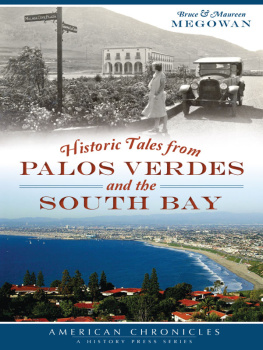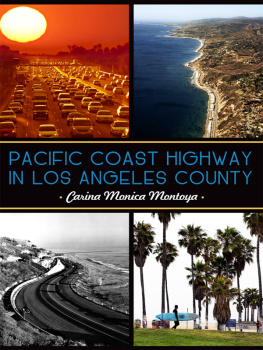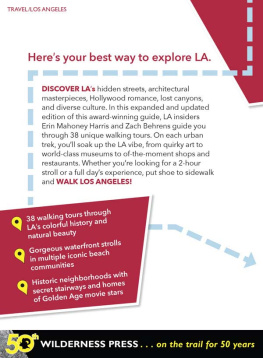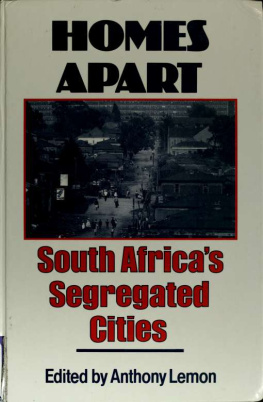

Published by The History Press
Charleston, SC 29403
www.historypress.net
Copyright 2014 by Bruce L. Megowan and Maureen D. Megowan
All rights reserved
Photos taken by and courtesy of Bruce L. Megowan unless otherwise noted.
First published 2014
e-book edition 2014
ISBN 978.1.62585.144.4
Library of Congress Cataloging-in-Publication Data
Megowan, Bruce.
Historic tales from Palos Verdes and the South Bay / Bruce and Maureen Megowan.
pages cm
Includes bibliographical references.
print edition ISBN 978-1-62619-607-0
1. Palos Verdes Peninsula (Calif.)--History. 2. Los Angeles Metropolitan Area--History. I. Megowan, Maureen. II. Title.
F869.P25M45 2014
979.493--dc23
2014021069
Notice: The information in this book is true and complete to the best of our knowledge. It is offered without guarantee on the part of the authors or The History Press. The authors and The History Press disclaim all liability in connection with the use of this book.
All rights reserved. No part of this book may be reproduced or transmitted in any form whatsoever without prior written permission from the publisher except in the case of brief quotations embodied in critical articles and reviews.
CONTENTS
PREFACE
In 2003, we decided to create a website for Maureens business as a Realtor for the Palos Verdes Peninsula and South Bay beach communities. As part of this process, we wanted to include the history of the cities within which we worked. As we researched this, we were amazed to find that there was no online resource for the history of the Palos Verdes Peninsula, other than some collections of historical photos.
The more research we did, the more fascinated we became about the exciting history of the South Bay of Los Angeles and the Palos Verdes Peninsula. The more we dug into the historical archives of the Palos Verdes Public Library local resource room, the more we wanted to know. Our local history became a passion for us. The results of this can be seen in this book, as well as on our local history web page (http://www.southbayhistory.com) and on our website (http://www.maureenmegowan.com).
At the beginning of 2011, Warren Dow, publisher of South Bay Digs magazine, suggested that we write a biweekly history article for his magazine as part of our ad placement. He believed that this would demonstrate our unique local knowledge of our market, as well as our love and appreciation for what makes the Palos Verdes Peninsula and the South Bay such wonderful places to live. Thus began our article series entitled South Bay History Tid-Bits. This book is a compilation of those articles.
We have lived in the South Bay for forty years, beginning in Manhattan Beach and Redondo Beach, and we have raised three children while living in the Lunada Bay area of Palos Verdes Estates for thirty years. Many of the subjects of the articles included in this book came about simply by our driving around the South Bay and the Palos Verdes Peninsula, seeing interesting things and wondering about their history or the explanations for their existence. Our love for the area has been enhanced by learning the fascinating history of our beautiful community, and we hope that you have the same reaction while reading our book.
ACKNOWLEDGEMENTS
The authors would like to recognize the valuable assistance the following wonderful people gave us in compiling the information and many of the photographs used in this book: Don Christy (son of Suzanne Vanderlip and stepson of John Vanderlip); Vicki Mack; Warren Dow (publisher of South Bay Digs magazine); Daniel Pinkam (owner of the Portuguese Bend Gatehouse); Kelvin Vanderlip Jr.; Narcissa Vanderlip; the volunteer docents in the local history room of the Palos Verdes Public Library, particularly Marjene Blinn, Dotty Agronick and Therese Anlauf; Monique Sugimoto of the Palos Verdes Public Library staff; Marilyn Ron of the Antique Attic in Torrance; Steve Meisenholder of the Manhattan Beach Historical Society; Jan Dennis; and Gail Fornasiere of the Catalina Island Museum.
PART I
PALOS VERDES HISTORY TALES
Palos Verdess Early American Indian Inhabitants
While first described in 1542 by Portuguese explorer Juan Cabrillo, for almost three centuries the Palos Verdes Peninsula remained undisturbed and the exclusive domain of the local Indians, whose artifacts are still being unearthed. One of the richest treasure-troves found in Palos Verdes, archaeologically speaking, bordered Torrance on a bluff overlooking Malaga Cove. The University of Southern California (USC) and the Southwest Museum excavated the area in 1936 and 1937 and found thousands of artifacts. Eventually, archaeologists used radiocarbon dating and found that the Malaga Cove site had been inhabited by humans for at least 7,100 years. The early inhabitants found so much game, seafood and wild plants in the area that they never needed to develop farming.
The most recent Native Americans to live in Palos Verdes were members of the Tongva tribe, who spoke a Shoshone language. Most recentlybetween 1,000 and 235 years agoa group called the Chowignas lived in Malaga Cove and at other sites in Palos Verdes. Chowigna villages stretched from the South Bay to Catalina Island. The biggest village in the area, though, was believed to be at Machado Lake, between Gaffey Street and the 110 Freeway. It was called Suang Na.
The Tongvas did not use a written language, but their myths and superb knowledge of their environment were passed down from one generation to the next through storytelling and teaching. Large trees did not grow in this part of California, so they built houses with frames made of willow poles. They also constructed reed boats and sealed them with tar or asphalt found on the beach. The Spaniards called the native people after the names of nearby missions. The natives in the Los Angeles area became known as the Gabrielinos, because they were the closest to the Mission San Gabriel.

Tongva Village as seen at the Palos Verdes Interpretive Center. Photo by Bruce Megowan.
During the summers, the Tongvas camped along the ocean and hunted in places such as Abalone Cove for fish, seals, sea otters, abalone and other shellfish using their canoes. During the cold, rainy season, they moved back to base camps on higher ground and hunted deer, rabbits and squirrels.
For more than two hundred years after the first explorers came, the Spaniards occasionally met and traded with the Tongva people. In the late 1700s, the Spaniards began to permanently settle the Palos Verdes Peninsula area. As they moved in with their cattle, horses and new crops, the native animals and plants on which the Tongvas relied for their survival began to disappear. The Spanish began to persuade the Americans Indians to give up their old way of life and move to the Spanish missions and ranchos, where they would learn farming and cattle raising. The Spanish missions interrupted life for the Chowignas. At the Malaga Cove site, the most recent artifacts found nearest the surface were glass beads that the Spanish brought. An estimated 150 people lived at the site in its last days, in about 1775.
Bixby Ranch
In 1882, the Rancho de los Palos Verdes land grant, once owned by the Sepulveda family, was partitioned into seventeen parcels as part of a complex legal settlement. The largest share, sixteen thousand acres, which included most of the Palos Verdes Peninsula, went to rancher Jotham Bixby. Bixby built his ranch house near where the Peninsula Center and Avenue of the Peninsula shopping centers currently stand.
Next page











